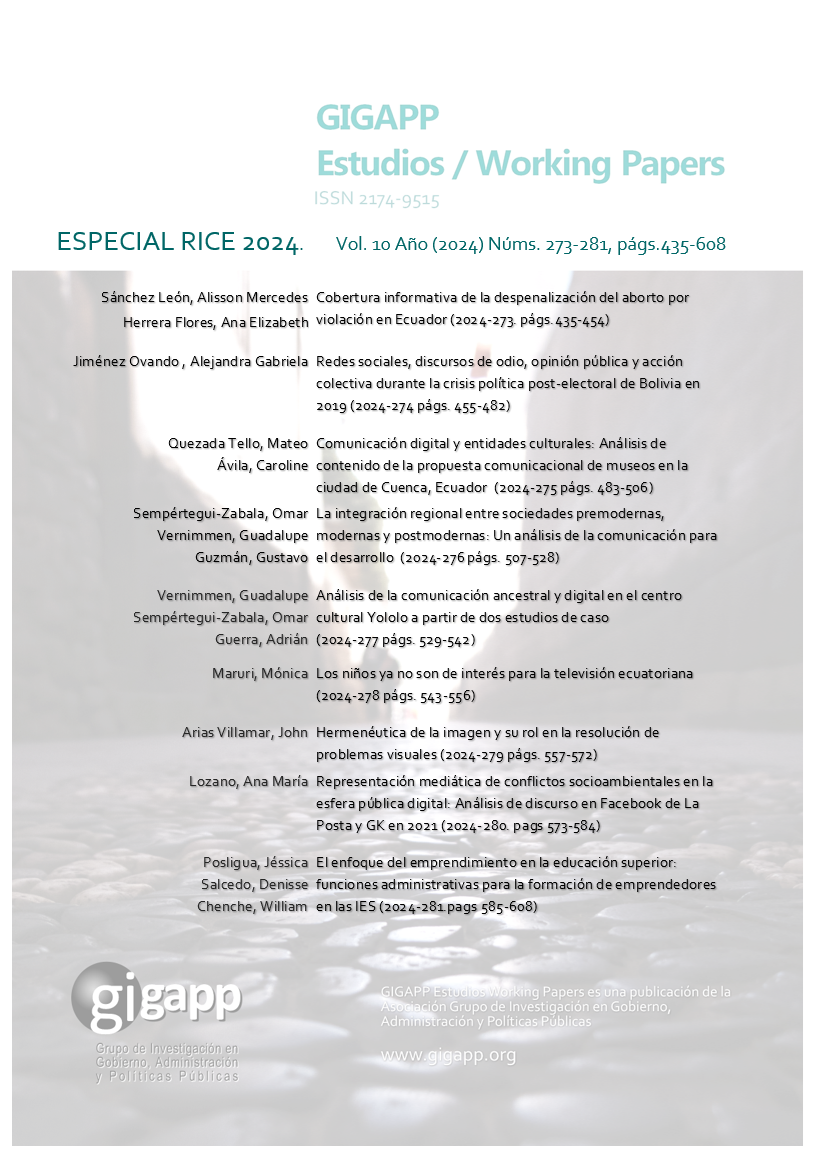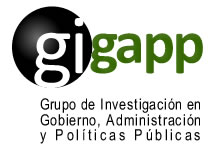Análisis de la comunicación ancestral y digital en el centro cultural Yololo a partir de dos estudios de caso
Resumen
La relación entre redes sociales y usuarios ha permitido el intercambio en tiempo real y la expansión de ideas, costumbres, ideologías y estereotipos, en virtud de fenómenos vinculados a la globalización. Esto incide en el desplazamiento de prácticas y rituales ancestrales, espirituales y religiosos, antaño anclados en tradiciones, territorios y grupos sociales concretos pero cada vez más desplazados del contexto rural y amazónico, al urbano y citadino, con usos de brebajes de plantas consideradas medicinales como el cactus de aguacolla o San Pedro (Echinopsis pachanoi). El presente trabajo tiene como objetivo analizar la percepción sobre culturas, interculturalidad y medicinas ancestrales en redes sociales. Esta investigación es de tipo descriptiva y propone el estudio a profundidad de dos casos utilizando una metodología cualitativa y etnográfica, en la cual se examina las variables: comunicación y cultura, y específicamente, medicinas ancestrales, con el estudio de las percepciones de dos sujetos de estudio asistentes al centro cultural Yololo Chicomoztoc Teocalli en la comuna San Pedro de Chongón en Guayaquil, Ecuador. El análisis se basa en la red social instagram, mediante la observación no participativa, así también, con entrevistas en profundidad y fundamentación de la literatura académica. Los hallazgos parciales de la investigación determinan que los prejuicios y la falta de información, entre otros rezagos históricos, ha promovido el menosprecio a las medicinas ancestrales y a las raíces precoloniales, consideradas como subalternas y bárbaras o estigmatizadas desde una marcada folclorización cultural.
Descargas
Citas
Barrett, F. S., Johnson, M. W., & Griffiths, R. R. (2015). Validation of the revised Mystical Experience Questionnaire in experimental sessions with psilocybin. Journal of Psychopharmacology, 29(11), 1182–1190. https://doi.org/10.1177/0269881115609019
Barsuglia, J., Davis, A. K., Palmer, R., Lancelotta, R., Windham-Herman, A. M., Peterson, K., Griffiths, R. R. (2018). Intensity of mystical experiences occasioned by 5-MeO-DMT and comparison with a prior psilocybin study. Frontiers in Psychology, 9(DEC), 1–6. https://doi.org/10.3389/fpsyg.2018.02459
Brabazon, T. (2012). Digital Dialogues and Community 2.0. Digital Dialogues and Community 2.0. https://doi.org/10.1533/9781780633022
Calleris, R. (2019). Aho Metakuye Oyasin “Todos somos familia”: ¿Cómo la organización interna del camino espiritual Fuego Sagrado de Itzachilatlan refleja o modifica dinámicas sociales relacionadas con género, “raza” e interacciones interculturales? Universidad San Francisco de Quito USFQ.
Chantre y Herrera, J. (1901). Historia de las Misiones de la Compañía de Jesús. Madrid: IMPRENTA DE A. AVSIAL. Retrieved from Imprenta de A. Avisal
Descola, P. (2021). Oltre natura e cultura (Press Graf). Italia.
Drouot, P. (2001). El chamán, el físico y el místico. Un universo donde lo espiritual y lo material dibujan una misma línea.
Fernandez Gonzalez, Loreto; Bravo Valenzuela, P. (2020). carta al editor / letter to the editor Expertos y redes sociales: ¿Cómo comunicarnos en tiempos de pandemia? Revista Médica de Chile, 148, 560–561
Flanagan, T. W., & Nichols, C. D. (2018). Psychedelics as anti-inflammatory agents. International Review of Psychiatry, 30(4), 363–375. https://doi.org/10.1080/09540261.2018.1481827
Flores, Juan José; Morán, Jorge; Rodríguez, J. J. (2020). Las redes sociales. Universidad de San Martín de Porres- USMP, 169–176. https://doi.org/10.7560/318188-025
Griffiths, R. R., Johnson, M. W., Richards, W. A., Richards, B. D., McCann, U., & Jesse, R. (2011). Psilocybin occasioned mystical-type experiences: Immediate and persisting dose-related effects. Psychopharmacology, 218(4), 649–665. https://doi.org/10.1007/s00213-011-2358-5
Hartogsohn, I. (2017). Constructing drug effects: A history of set and setting. Drug Science, Policy and Law, 3, 1–17. https://doi.org/10.1177/2050324516683325
Heaven, R. (2013). Cactus of mystery (Park Stree). Rochester, Vermont.
Heaven, R., & Charing, H. (2006). Plant Supirit shamanism. Traditional Techniques for healing the soul. (Destiny Bo). Uited States of America
Holoyda, B. (2020). Psychedelic Psychiatry: Preparing for Novel Treatments Involving Altered States of Consciousness. Psychiatric Services (Washington, D.C.), 71(12), 1297–1299. https://doi.org/10.1176/appi.ps.202000213
James, E., Keppler, J., L Robertshaw, T., & Sessa, B. (2022). N,N-dimethyltryptamine and Amazonian ayahuasca plant medicine. Human Psychopharmacology, 37(3). https://doi.org/10.1002/hup.2835
Johansen, P. O., & Krebs, T. S. (2015). Psychedelics not linked to mental health problems or suicidal behavior: A population study. Journal of Psychopharmacology, 29(3), 270–279. https://doi.org/10.1177/0269881114568039
Lynch, T. (1980). Guitarrero Cave: Early Man in the Andes. New York: Academic Press.
Manrique, N. (2016). Una alucinación consensual. Redes sociales, cultura y socialización en internet (Pontificia).
Matthews, J. (2014). La biblia del chamanismo. (Gaia). Quito, Ecuador.
Naranjo, C. (2015). Ayahuasca (La llave). Argentina.
Newberg, A. B. (2017). Of Roots and Fruits: A Comparison of Psychedelic and Nonpsychedelic Mystical Experiences. Journal of Humanistic Psychology, 57(4), 338–353. https://doi.org/10.1177/0022167816674625
Nutt, D. (2019). Psychedelic drugs—a new era in psychiatry? Dialogues in Clinical Neuroscience, 21(2), 139–147. https://doi.org/10.31887/DCNS.2019.21.2/dnutt
Ochoa Quispe, F. Z., & Barragán Condori, M. (2022). El uso en exceso de las redes sociales en medio de la pandemia. ACADEMO Revista de Investigación En Ciencias Sociales y Humanidades, 9(1), 85–92. https://doi.org/10.30545/academo.2022.ene- jun.8
Ott, J. (1996). Pharmacotheon: Entheogenic Drugs, their plant sources and history (2nd ed.). Kennewick, Washington: Natural Products CO.
Reynoso, C. (2011). Redes sociales y complejidad: Modelos interdisciplinarios en la gestión sostenible de la sociedad y la cultura. Universidad de Buenos Aires, 403.
Rojas, N. (2020). Chamanes en la red: Mercantilización de la cultura y uso de las redes sociales para proliferar discursos entorno a lo chamánico. Lima, Perú.
Thompson, C., & Szabo, A. (2020). Psychedelics as a Novel Approach to Treating Autoimmune Conditions. Immunology Letters. https://doi.org/10.1016/j.imlet.2020.10.001
Thompson, L. M., Clark, M., Cadman, B., Canúz, E., & Smith, K. R. (2011). Exposures to High Levels of Carbon Monoxide from Wood-fired Temazcal (Steam Bath) Use in Highland Guatemala. International Journal of Occupational and Environmental Health, 17(2), 103–112. https://doi.org/10.1179/107735211799030979
Vernimmen, Estrella, Del Pozo, (2018) Nuevas identidades digitales en Ecuador, el caso del chat privado de Twitter: ES-CORIA en: Investigación Multimedia: el análisis de contenido en la era digital, Ediciones Egregius, Serie Colección Comunicación y Pensamiento.
Wesson, D. R. (2011). Psychedelic drugs, Hippie counterculture, speed and phenobarbital treatment of sedative-hypnotic dependence: A journey to the Haight Ashbury in the sixties. Journal of Psychoactive Drugs, 43(2), 153–164. https://doi.org/10.1080/02791072.2011.587708
Yaden, D. B., Le Nguyen, K. D., Kern, M. L., Belser, A. B., Eichstaedt, J. C., Iwry, J.,
Derechos de autor 2024 Guadalupe Vernimmen, Omar Sempértegui-Zabala, Adrián Guerra (Autor/a)

Esta obra está bajo licencia internacional Creative Commons Reconocimiento-NoComercial-CompartirIgual 4.0.
Aquellos autores/as que tengan publicaciones con esta revista, aceptan los términos siguientes:
a. Los autores/as conservarán sus derechos de autor y garantizarán a la revista el derecho de primera publicación de su obra, el cuál estará simultáneamente sujeto a la Licencia de reconocimiento de Creative Commons Attribution-NonCommercial-ShareAlike 4.0 International (CC BY-NC-SA 4.0) que permite a terceros compartir la obra siempre que se indique su autor y su primera publicación esta revista.
Con esta licencia de acceso abierto, los lectores (usuarios) pueden:
- Compartir — copiar y redistribuir el material en cualquier medio o formato
- Adaptar — remezclar, transformar y construir a partir del material
Bajo los siguientes términos:
-
Atribución — usarios deberán dar crédito de manera adecuada, brindar un enlace a la licencia, e indicar si se han realizado cambios. Puede hacerlo en cualquier forma razonable, pero no de forma tal que sugiera que usted o su uso tienen el apoyo de la licenciante.
-
NoComercial — usuarios no puede hacer uso del material con propósitos comerciales.
-
CompartirIgual — Si remezcla, transforma o crea a partir del material, usuarios deben distribuir su contribución bajo la misma licencia del original.
-
Sin restricciones adicionales: los usuarios no pueden aplicar términos legales o medidas tecnológicas que restrinjan legalmente a otros de hacer cualquier cosa que permita la licencia.
b. Los autores/as podrán adoptar otros acuerdos de licencia no exclusiva de distribución de la versión de la obra publicada (p. ej.: depositarla en un archivo telemático institucional o publicarla en un volumen monográfico) siempre que se indique la publicación inicial en esta revista
c. Se permite y recomienda a los autores/as difundir su obra a través de Internet (p. ej.: en archivos telemáticos institucionales o en su página web) antes y durante el proceso de envío, lo cual puede producir intercambios interesantes y aumentar las citas de la obra publicada. (Véase El efecto del acceso abierto).



